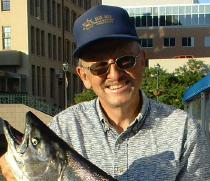Trophy Lake Trout Fishing Lake Michigan
By Milwaukee fishing charter Capt. Jim Hirt
I received this e-mail recently and thought it was a good question that more anglers would be interested in. Should you have a question please e-mail me from my Website contact us page http://www.bluemaxcharters.com I will be pleased to answer. My charter season will be under way soon and it may take a while to get back to you. Read all my articles and see video fish reports at http://www.jimhirt.com
Captain Jim:
I was reading an old article you posted a few years back regarding trolling cowbells and spin-n-glows. I was wondering if you could tell me what your leader setup is on a rig like that.
I made 5 cowbell rigs, 24 inches long, followed by a spin-n-glow on a 24 inch leader as well. I was going to attach that directly to a 3 way swivel but was wondering if I’ll need a greater leader length?
Lake Trout head to tail
Before we get directly into the answer I would like to provide more information on this species and presentations that are effective for them. I would like to explore location, presentation and lure selection for Lake Trout. Fishermen everywhere covet them for their table excellence giving them a nickname of poor man’s Lobster. Lake Trout baked or poached and served with melted butter is a feast fit for a king.
Ecosystem of the Lake Trout
This slow growing member of the Char family can attain a life of over fifty years and have been known to grow to more than 50 inches and reach over 100 pounds. Lake Trout are mature enough to reproduce when they are six or seven years old. Some Lake Trout respond to a homing instinct. They return to the same spawning grounds year after year, while others do not. This trout lives in deep cold lakes. Their preferred water temperature is 50 degrees or below. In the summer they stay deep and can usually be caught by deep trolling. But as the water cools with the fall season and into spring, artificial lures and flies may take lake trout fished shallower, near shore.
Rules of the road
Finding a trophy may be a difficult task although I feel following a few rules will augment your odds for success. I have found that in twenty years of fishing my biggest have come on spoons. I believe the reason for this is spoons will maintain an attractive appearance at very slow speeds. When you think Lakers think slow. This very cold water species has the slowest metabolism of all the game fish. If you have not caught a Lake Trout, you are trolling too fast. The bigger the Lake Trout the colder the water they prefer and the slower they move. A quality large spoon that trolls well at speeds below one mile per hour is required. Keeping in mind that you will be working in deep water below 100 feet.
Don’t forget about color
The color choices should be in the bottom half spectrum of the rainbow. There is not much light down there and green, blue, indigo violet colors will sustain some color at these depths. A silver plated spoon will reflect light better in low light and used in combination with the colors is a good choice. You might try the new Badger Tackle Reaper glow in the dark spoons as well. They were very productive for me this last season. The lack of light has brought me to my favorite presentation. In some cases bouncing the bottom is the only way to provoke a strike.
Set up defined
Use a wire line rod with 30 pound wire terminated with a plastic keel. The plastic keel has three positions to attach to it. One goes to the wire line another directly to the weight. Some anglers use a mono line from the keel to the weight so if you get hung up the mono will break and you won’t loose everything. Use eight ounces to one pound weight for good contact to the bottom. The third position is used for the connection of bait or lure. Use a three foot 40 pound monofilament lead to an 8 inch silver or glow in the dark dodger and a 3 foot lead to the spoon. Cowbells are a similar presentation with a few changes. From the keel attach the cowbells and then two foot leader to the spoon. When you would like to use a Spin N Glow attach a three foot 40 pound leader behind the Cowbells then the dodger and two feet to the Spin N Glow.
Working it
Troll with the bottom contour letting out enough wire to allow the ball to bounce on the bottom. A word of caution, some bottoms have lots of hang ups and it takes a constant vigilance on your part to avoid hanging up and still keep constant bottom contact.
As you read earlier, when the water cools in fall they return to the same spawning grounds year after year. The eggs are deposited over a boulder-strewn or rubble bottom structure, in depths from 40 feet to about one foot. This affords the angler another opportunity to get into some serious laker action. Work this shallow water with the same wire line rod. Go with 4 ounces of weight no flasher and standard Reaper Big Joe red/green or Reaper Peacock blue/green spoons. Motor troll the shallows while hand holding the rod bouncing the bottom as you go it‘s a blast.
Let’s wrap this up with my favorite Lake Trout lures. Dodgers and magnum spoons are my first choice with dodger Spin n Glows a close second. The two most productive Lake Trout spoons for me in recent years are the glow in the dark Reaper Green Fox Glow and Fish n Chip Silver both sold by http://www.badgertackle.com The standard Reaper in the silver combinations are best for shallow water.
Good Luck let’s go fishing! Jim charters out of Milwaukee, WI. with Blue Max Charters. He can be reached at 414-828-1094 or web site at http://www.bluemaxcharters.com Copyright© 2011 James J. Hirt, All Rights Reserved.





